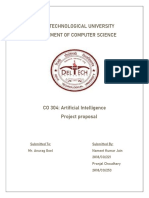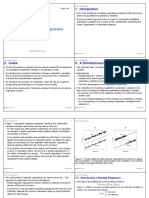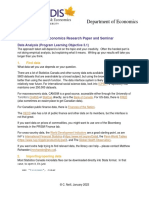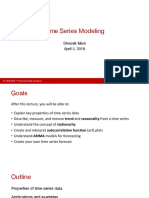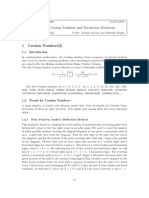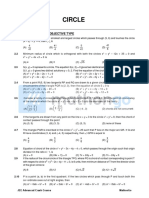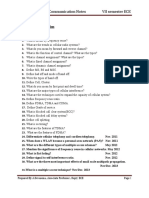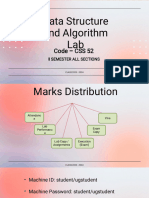Econometrics - Chapter 1 - Introduction To Econometrics - Shalabh, IIT Kanpur
Econometrics - Chapter 1 - Introduction To Econometrics - Shalabh, IIT Kanpur
Uploaded by
Nameet JainCopyright:
Available Formats
Econometrics - Chapter 1 - Introduction To Econometrics - Shalabh, IIT Kanpur
Econometrics - Chapter 1 - Introduction To Econometrics - Shalabh, IIT Kanpur
Uploaded by
Nameet JainOriginal Title
Copyright
Available Formats
Share this document
Did you find this document useful?
Is this content inappropriate?
Copyright:
Available Formats
Econometrics - Chapter 1 - Introduction To Econometrics - Shalabh, IIT Kanpur
Econometrics - Chapter 1 - Introduction To Econometrics - Shalabh, IIT Kanpur
Uploaded by
Nameet JainCopyright:
Available Formats
Chapter 1
Introduction to Econometrics
Econometrics deals with the measurement of economic relationships. It is an integration of economics,
mathematical economics and statistics with an objective to provide numerical values to the parameters of
economic relationships. The relationships of economic theories are usually expressed in mathematical forms
and combined with empirical economics. The econometrics methods are used to obtain the values of
parameters which are essentially the coefficients of the mathematical form of the economic relationships.
The statistical methods which help in explaining the economic phenomenon are adapted as econometric
methods. The econometric relationships depict the random behaviour of economic relationships which are
generally not considered in economics and mathematical formulations.
It may be pointed out that the econometric methods can be used in other areas like engineering sciences,
biological sciences, medical sciences, geosciences, agricultural sciences etc. In simple words, whenever there
is a need of finding the stochastic relationship in mathematical format, the econometric methods and tools
help. The econometric tools are helpful in explaining the relationships among variables.
Econometric Models:
A model is a simplified representation of a real-world process. It should be representative in the sense that it
should contain the salient features of the phenomena under study. In general, one of the objectives in
modeling is to have a simple model to explain a complex phenomenon. Such an objective may sometimes
lead to oversimplified model and sometimes the assumptions made are unrealistic. In practice, generally, all
the variables which the experimenter thinks are relevant to explain the phenomenon are included in the
model. Rest of the variables are dumped in a basket called “disturbances” where the disturbances are random
variables. This is the main difference between economic modeling and econometric modeling. This is also
the main difference between mathematical modeling and statistical modeling. The mathematical modeling is
exact in nature, whereas the statistical modeling contains a stochastic term also.
An economic model is a set of assumptions that describes the behaviour of an economy, or more generally, a
phenomenon.
Econometrics | Chapter 1 | Introduction to Econometrics | Shalabh, IIT Kanpur
1
An econometric model consists of
- a set of equations describing the behaviour. These equations are derived from the economic model
and have two parts – observed variables and disturbances.
- a statement about the errors in the observed values of variables.
- a specification of the probability distribution of disturbances.
Aims of econometrics:
The three main aims econometrics are as follows:
1. Formulation and specification of econometric models:
The economic models are formulated in an empirically testable form. Several econometric models can be
derived from an economic model. Such models differ due to different choice of functional form,
specification of the stochastic structure of the variables etc.
2. Estimation and testing of models:
The models are estimated on the basis of the observed set of data and are tested for their suitability. This is
the part of the statistical inference of the modelling. Various estimation procedures are used to know the
numerical values of the unknown parameters of the model. Based on various formulations of statistical
models, a suitable and appropriate model is selected.
3. Use of models:
The obtained models are used for forecasting and policy formulation, which is an essential part in any policy
decision. Such forecasts help the policymakers to judge the goodness of the fitted model and take necessary
measures in order to re-adjust the relevant economic variables.
Econometrics and statistics:
Econometrics differs both from mathematical statistics and economic statistics. In economic statistics, the
empirical data is collected recorded, tabulated and used in describing the pattern in their development over
time. The economic statistics is a descriptive aspect of economics. It does not provide either the explanations
of the development of various variables or measurement of the parameters of the relationships.
Econometrics | Chapter 1 | Introduction to Econometrics | Shalabh, IIT Kanpur
2
Statistical methods describe the methods of measurement which are developed on the basis of controlled
experiments. Such methods may not be suitable for the economic phenomenon as they don’t fit in the
framework of controlled experiments. For example, in real-world experiments, the variables usually change
continuously and simultaneously, and so the set up of controlled experiments are not suitable.
Econometrics uses statistical methods after adapting them to the problems of economic life. These adopted
statistical methods are usually termed as econometric methods. Such methods are adjusted so that they
become appropriate for the measurement of stochastic relationships. These adjustments basically attempt to
specify attempts to the stochastic element which operate in real-world data and enters into the determination
of observed data. This enables the data to be called a random sample which is needed for the application of
statistical tools.
The theoretical econometrics includes the development of appropriate methods for the measurement of
economic relationships which are not meant for controlled experiments conducted inside the laboratories.
The econometric methods are generally developed for the analysis of non-experimental data.
The applied econometrics includes the application of econometric methods to specific branches of
econometric theory and problems like demand, supply, production, investment, consumption etc. The applied
econometrics involves the application of the tools of econometric theory for the analysis of the economic
phenomenon and forecasting economic behaviour.
Types of data
Various types of data is used in the estimation of the model.
1. Time series data
Time series data give information about the numerical values of variables from period to period and are
collected over time. For example, the data during the years 1990-2010 for monthly income constitutes a time
series of data.
2. Cross-section data
The cross-section data give information on the variables concerning individual agents (e.g., consumers or
produces) at a given point of time. For example, a cross-section of a sample of consumers is a sample of
family budgets showing expenditures on various commodities by each family, as well as information on
family income, family composition and other demographic, social or financial characteristics.
Econometrics | Chapter 1 | Introduction to Econometrics | Shalabh, IIT Kanpur
3
3. Panel data:
The panel data are the data from a repeated survey of a single (cross-section) sample in different periods of
time.
4. Dummy variable data
When the variables are qualitative in nature, then the data is recorded in the form of the indicator function.
The values of the variables do not reflect the magnitude of the data. They reflect only the presence/absence
of a characteristic. For example, variables like religion, sex, taste, etc. are qualitative variables. The variable
`sex’ takes two values – male or female, the variable `taste’ takes values-like or dislike etc. Such values are
denoted by the dummy variable. For example, these values can be represented as ‘1’ represents male and ‘0’
represents female. Similarly, ‘1’ represents the liking of taste, and ‘0’ represents the disliking of taste.
Aggregation problem:
The aggregation problems arise when aggregative variables are used in functions. Such aggregative variables
may involve.
1. Aggregation over individuals:
For example, the total income may comprise the sum of individual incomes.
2. Aggregation over commodities:
The quantity of various commodities may be aggregated over, e.g., price or group of commodities. This is
done by using suitable index.
3. Aggregation over time periods
Sometimes the data is available for shorter or longer time periods than required to be used in the functional
form of the economic relationship. In such cases, the data needs to be aggregated over the time period. For
example, the production of most of the manufacturing commodities is completed in a period shorter than a
year. If annual figures are to be used in the model, then there may be some error in the production function.
4. Spatial aggregation:
Sometimes the aggregation is related to spatial issues. For example, the population of towns, countries, or the
production in a city or region etc..
Such sources of aggregation introduce “aggregation bias” in the estimates of the coefficients. It is important
to examine the possibility of such errors before estimating the model.
Econometrics | Chapter 1 | Introduction to Econometrics | Shalabh, IIT Kanpur
4
Econometrics and regression analysis:
One of the very important roles of econometrics is to provide the tools for modeling on the basis of given
data. The regression modeling technique helps a lot in this task. The regression models can be either linear or
non-linear based on which we have linear regression analysis and non-linear regression analysis. We will
consider only the tools of linear regression analysis and our main interest will be the fitting of the linear
regression model to a given set of data.
Linear regression model
Suppose the outcome of any process is denoted by a random variable y , called as dependent (or study)
variable, depends on k independent (or explanatory) variables denoted by X 1, X 2 ,..., X k . Suppose the
behaviour of y can be explained by a relationship given by
y f ( X 1, X 2 ,..., X k , 1 , 2 ,..., k )
where f is some well-defined function and 1 , 2 ,..., k are the parameters which characterize the role and
contribution of X 1, X 2 ,..., X k , respectively. The term reflects the stochastic nature of the relationship
between y and X 1, X 2 ,..., X k and indicates that such a relationship is not exact in nature. When 0, then
the relationship is called the mathematical model otherwise the statistical model. The term “model” is
broadly used to represent any phenomenon in a mathematical framework.
A model or relationship is termed as linear if it is linear in parameters and non-linear, if it is not linear in
parameters. In other words, if all the partial derivatives of y with respect to each of the parameters
1 , 2 ,..., k are independent of the parameters, then the model is called as a linear model. If any of the
partial derivatives of y with respect to any of the 1 , 2 ,..., k is not independent of the parameters, the
model is called non-linear. Note that the linearity or non-linearity of the model is not described by the
linearity or non-linearity of explanatory variables in the model.
For example
y 1 X 12 2 X 2 3 log X 3
is a linear model because y / i , (i 1, 2,3) are independent of the parameters i , (i 1, 2,3). On the other
hand,
y 12 X 1 2 X 2 3 log X
Econometrics | Chapter 1 | Introduction to Econometrics | Shalabh, IIT Kanpur
5
is a non-linear model because y / 1 2 1 X 1 depends on 1 although y / 2 and y / 3 are independent
of any of the 1 , 2 or 3 .
When the function f is linear in parameters, then y f ( X 1 , X 2 ,..., X k , 1 , 2 ,..., k ) is called a linear
model and when the function f is non-linear in parameters, then it is called a non-linear model. In general,
the function f is chosen as
f ( X 1 , X 2 ,..., X k , 1 , 2 ..., k ) 1 X 1 2 X 2 ... k X k
to describe a linear model. Since X 1 , X 2 ,..., X k are pre-determined variables and y is the outcome, so both
are known. Thus the knowledge of the model depends on the knowledge of the parameters 1 , 2 ,..., k .
The statistical linear modeling essentially consists of developing approaches and tools to determine
1 , 2 ,..., k in the linear model
y 1 X 1 2 X 2 ... k X k
given the observations on y and X 1, X 2 ,..., X k .
Different statistical estimation procedures, e.g., method of maximum likelihood, the principle of least
squares, method of moments etc. can be employed to estimate the parameters of the model. The method of
maximum likelihood needs further knowledge of the distribution of y whereas the method of moments and
the principle of least squares do not need any knowledge about the distribution of y .
The regression analysis is a tool to determine the values of the parameters given the data on y and
X 1, X 2 ,..., X k . The literal meaning of regression is “to move in the backward direction”. Before discussing
and understanding the meaning of “backward direction”, let us find which of the following statements is
correct:
S1 : model generates data or
S 2 : data generates the model.
Obviously, S1 is correct. It can be broadly thought that the model exists in nature but is unknown to the
experimenter. When some values to the explanatory variables are provided, then the values for the output or
study variable are generated accordingly, depending on the form of the function f and the nature of the
phenomenon. So ideally, the pre-existing model gives rise to the data. Our objective is to determine the
Econometrics | Chapter 1 | Introduction to Econometrics | Shalabh, IIT Kanpur
6
functional form of this model. Now we move in the backward direction. We propose to first collect the data
on study and explanatory variables. Then we employ some statistical techniques and use this data to know
the form of function f . Equivalently, the data from the model is recorded first and then used to determine
the parameters of the model. The regression analysis is a technique which helps in determining the statistical
model by using the data on study and explanatory variables. The classification of linear and non-linear
regression analysis is based on the determination of linear and non-linear models, respectively.
Consider a simple example to understand the meaning of “regression”. Suppose the yield of the crop ( y )
depends linearly on two explanatory variables, viz., the quantity of fertilizer ( X 1 ) and level of irrigation
( X 2 ) as
y 1 X 1 2 X 2 .
There exist the true values of 1 and 2 in nature but are unknown to the experimenter. Some values on y
are recorded by providing different values to X 1 and X 2 . There exists some relationship between y and
X 1 , X 2 which gives rise to a systematically behaved data on y , X 1 and X 2 . Such a relationship is unknown
to the experimenter. To determine the model, we move in the backward direction in the sense that the
collected data is used to determine the unknown parameters 1 and 2 of the model. In this sense, such an
approach is termed as regression analysis.
The theory and fundamentals of linear models lay the foundation for developing the tools for regression
analysis that are based on valid statistical theory and concepts.
Steps in regression analysis
Regression analysis includes the following steps:
Statement of the problem under consideration
Choice of relevant variables
Collection of data on relevant variables
Specification of model
Choice of method for fitting the data
Fitting of model
Model validation and criticism
Using the chosen model(s) for the solution of the posed problem.
Econometrics | Chapter 1 | Introduction to Econometrics | Shalabh, IIT Kanpur
7
These steps are examined below.
1. Statement of the problem under consideration:
The first important step in conducting any regression analysis is to specify the problem and the objectives to
be addressed by the regression analysis. The wrong formulation or the wrong understanding of the problem
will give the wrong statistical inferences. The choice of variables depends upon the objectives of the study
and understanding of the problem. For example, the height and weight of children are related. Now there can
be two issues to be addressed.
(i) Determination of height for a given weight, or
(ii) determination of weight for a given height.
In case 1, the height is the response variable, whereas weight is the response variable in case 2. The role of
explanatory variables is also interchanged in cases 1 and 2.
2. Choice of relevant variables:
Once the problem is carefully formulated and objectives have been decided, the next question is to choose
the relevant variables. It has to be kept in mind that the correct choice of variables will determine the
statistical inferences correctly. For example, in any agricultural experiment, the yield depends on explanatory
variables like quantity of fertilizer, rainfall, irrigation, temperature etc. These variables are denoted by
X 1 , X 2 ,..., X k as a set of k explanatory variables.
3. Collection of data on relevant variables:
Once the objective of the study is clearly stated, and the variables are chosen, the next question arises how to
collect data on such relevant variables. The data is essentially the measurement of these variables. For
example, suppose we want to collect the data on age. For this, it is important to know how to record the data
on age. Then either the date of birth can be recorded which will provide the exact age on any specific date or
the age in terms of completed years as on specific date can be recorded. Moreover, it is also important to
decide whether the data has to be collected on variables as quantitative variables or qualitative variables. For
example, if the ages (in years) are 15,17,19,21,23, then these are quantitative values. If the ages are defined
by a variable that takes value 1 if ages are less than 18 years and 0 if the ages are more than 18 years, then
the earlier recorded data is converted to 1,1,0,0,0. Note that there is a loss of information in converting the
quantitative data into qualitative data. The methods and approaches for qualitative and quantitative data are
also different. If the study variable is binary, then logistic and probit regressions etc. are used. If all
Econometrics | Chapter 1 | Introduction to Econometrics | Shalabh, IIT Kanpur
8
explanatory variables are qualitative, then analysis of variance technique is used. If some explanatory
variables are qualitative and others are quantitative, then analysis of covariance technique is used. The
techniques of analysis of variance and analysis of covariance are the special cases of regression analysis.
Generally, the data is collected on n subjects, then y on data, then y denotes the response or study variable
and y1 , y2 ,..., yn are the n values. If there are k explanatory variables X 1 , X 2 ,.., X k then xij denotes the i th
value of the j th variable i 1, 2,..., n; j 1, 2,..., k . The observation can be presented in the following table:
Notation for the data used in regression analysis
Observation number Response Explanatory variables
y X1 X 2 X k
1 y1 x11 x12 x1k
2 y2 x21 x22 x2 k
n yn xn1 xn 2 xnk
4. Specification of model:
The experimenter or the person working in the subject usually help in determining the form of the model.
Only the form of the tentative model can be ascertained, and it will depend on some unknown parameters.
For example, a general form will be like
y f ( X 1 , X 2 ,..., X k ; 1 , 2 ,..., k )
where is the random error reflecting mainly the difference in the observed value of y and the value of y
obtained through the model. The form of f ( X 1 , X 2 ,..., X k ; 1 , 2 ,..., k ) can be linear as well as non-linear
depending on the form of parameters 1 , 2 ,..., k . A model is said to be linear if it is linear in parameters.
For example,
y 1 X 1 2 X 12 3 X 2
y 1 2 ln X 2
are linear models whereas
y 1 X 1 22 X 2 3 X 2
y ln 1 X 1 2 X 2
are non-linear models. Many times, the non-linear models can be converted into linear models through some
transformations. So the class of linear models is wider than what it appears initially.
Econometrics | Chapter 1 | Introduction to Econometrics | Shalabh, IIT Kanpur
9
If a model contains only one explanatory variable, then it is called a simple regression model. When there
are more than one independent variables, then it is called a multiple regression model. When there is only
one study variable, the regression is termed as univariate regression. When there are more than one study
variables, the regression is termed as multivariate regression. Note that the simple and multiple regressions
are not same as univariate and multivariate regressions. The simple and multiple regression are determined
by the number of explanatory variables, whereas univariate and multivariate regressions are determined by
the number of study variables.
5. Choice of method for fitting the data:
After the model has been defined, and the data have been collected, the next task is to estimate the
parameters of the model based on the collected data. This is also referred to as parameter estimation or
model fitting. The most commonly used method of estimation is the least-squares method. Under certain
assumptions, the least-squares method produces estimators with desirable properties. The other estimation
methods are the maximum likelihood method, ridge method, principal components method etc.
6. Fitting of model:
The estimation of unknown parameters using appropriate method provides the values of the parameter.
Substituting these values in the equation gives us a usable model. This is termed as model fitting. The
estimates of parameters 1 , 2 ,..., k in the model
y f ( X 1 , X 2 ,..., X k , 1 , 2 ,..., k )
are denoted by ˆ1 , ˆ2 ,..., ˆk which gives the fitted model as
y f ( X 1 , X 2 ,..., X k , ˆ1 , ˆ2 ,..., ˆk ).
When the value of y is obtained for the given values of X 1 , X 2 ,..., X k , it is denoted as ŷ and called as fitted
value.
The fitted equation is used for prediction. In this case, ŷ is termed as the predicted value. Note that the
fitted value is where the values used for explanatory variables correspond to one of the n observations in the
data, whereas predicted value is the one obtained for any set of values of explanatory variables. It is not
generally recommended to predict the y -values for the set of those values of explanatory variables which lie
outside the range of data. When the values of explanatory variables are the future values of explanatory
variables, the predicted values are called forecasted values.
Econometrics | Chapter 1 | Introduction to Econometrics | Shalabh, IIT Kanpur
10
7. Model criticism and selection
The validity of the statistical method to be used for regression analysis depends on various assumptions.
These assumptions become the assumptions for the model and the data essentially. The quality of statistical
inferences heavily depends on whether these assumptions are satisfied or not. For making these assumptions
to be valid and to be satisfied, care is needed from the beginning of the experiment. One has to be careful in
choosing the required assumptions and to decide as well to determine if the assumptions are valid for the
given experimental conditions or not? It is also important to decide that the situations is which the
assumptions may not meet.
The validation of the assumptions must be made before drawing any statistical conclusion. Any departure
from the validity of assumptions will be reflected in the statistical inferences. In fact, the regression analysis
is an iterative process where the outputs are used to diagnose, validate, criticize and modify the inputs. The
iterative process is illustrated in the following figure.
Inputs Outputs
Theories Estimate Estimation of parameters
Model Confidence regions
Assumptions Tests of hypotheses
Data Graphical displays
Diagnosis,
Statistocal methods validation and
criticism
8. Objectives of regression analysis
The determination of the explicit form of the regression equation is the ultimate objective of regression
analysis. It is finally a good and valid relationship between study variable and explanatory variables. The
regression equation helps in understanding the interrelationships of variables among them. Such a
regression equation can be used for several purposes. For example, to determine the role of any explanatory
variable in the joint relationship in any policy formulation, to forecast the values of the response variable
for a given set of values of explanatory variables.
Econometrics | Chapter 1 | Introduction to Econometrics | Shalabh, IIT Kanpur
11
You might also like
- Full Download PDF of (Original PDF) Modern Macroeconomics (The MIT Press) by Sanjay K. Chugh All ChapterDocument43 pagesFull Download PDF of (Original PDF) Modern Macroeconomics (The MIT Press) by Sanjay K. Chugh All ChapterampadulaakiNo ratings yet
- Cineo 2560servicemanualDocument732 pagesCineo 2560servicemanualjrusalen1100% (1)
- Econometrics by Example PDFDocument1 pageEconometrics by Example PDFЮля ГордееваNo ratings yet
- Collaborative Task M1Document2 pagesCollaborative Task M1umang nathNo ratings yet
- HAN & STOEL (2016) - Meta-Analytic Review of TPB - Consumo Socialmente ResponsávelDocument14 pagesHAN & STOEL (2016) - Meta-Analytic Review of TPB - Consumo Socialmente ResponsávelGabriel Horn IwayaNo ratings yet
- Bank Queue Management System: Problem StatementDocument58 pagesBank Queue Management System: Problem StatementNameet JainNo ratings yet
- Line Follower Robot PDFDocument5 pagesLine Follower Robot PDFNameet Jain100% (1)
- Delhi Technological University Department of Computer ScienceDocument4 pagesDelhi Technological University Department of Computer ScienceNameet JainNo ratings yet
- Green Shift ReportDocument328 pagesGreen Shift ReportgauravmukhisjsNo ratings yet
- Student - Dummy Variable IssueDocument3 pagesStudent - Dummy Variable IssueShadman SakibNo ratings yet
- Chapter16 Distributed Lag ModelsDocument30 pagesChapter16 Distributed Lag ModelsdwqefNo ratings yet
- MacKinnon Critical Values For Cointegration Tests Qed WP 1227Document19 pagesMacKinnon Critical Values For Cointegration Tests Qed WP 1227henry amielNo ratings yet
- 6 - Dummy-Variable RegressionDocument12 pages6 - Dummy-Variable RegressionArsalan KhanNo ratings yet
- How To Use Log TableDocument2 pagesHow To Use Log TableArun M. PatokarNo ratings yet
- Stata Manual 2009Document222 pagesStata Manual 2009Ho VanNo ratings yet
- Statistics For EconomicsDocument58 pagesStatistics For EconomicsKintu GeraldNo ratings yet
- What Is The Modern Theory of Short Run Cost CurvesDocument2 pagesWhat Is The Modern Theory of Short Run Cost CurvesMayank JhaNo ratings yet
- Cost & Asset Accounting: Prof - Dr.G.M.MamoorDocument51 pagesCost & Asset Accounting: Prof - Dr.G.M.MamoorPIRZADA TALHA ISMAIL100% (1)
- Math LSE UndergraduateDocument71 pagesMath LSE UndergraduatejrodaschNo ratings yet
- Macro Economics H.L. Ahuja 2022Document368 pagesMacro Economics H.L. Ahuja 2022rathihimanshi27No ratings yet
- CMAP ECON 532 Health Economics II - Lecture Notes 2020Document217 pagesCMAP ECON 532 Health Economics II - Lecture Notes 2020stephanieacheampong8No ratings yet
- Lecture 1 ECN 2331 (Scope of Statistical Methods For Economic Analysis) - 1Document15 pagesLecture 1 ECN 2331 (Scope of Statistical Methods For Economic Analysis) - 1sekelanilunguNo ratings yet
- Lahore University of Management Sciences ECON 330 - EconometricsDocument3 pagesLahore University of Management Sciences ECON 330 - EconometricsshyasirNo ratings yet
- Introduction To Economics (EC1002)Document2 pagesIntroduction To Economics (EC1002)Geza bumNo ratings yet
- Complete Set Tutorial Sheets 1-10Document17 pagesComplete Set Tutorial Sheets 1-10APOORV AGARWALNo ratings yet
- EconometricsDocument320 pagesEconometricsNikshep AntonyNo ratings yet
- Econometrics For Dummies Chapter 1Document14 pagesEconometrics For Dummies Chapter 1obara33No ratings yet
- ECN 2215 - Last - Topic - New - Macroeconomics PDFDocument26 pagesECN 2215 - Last - Topic - New - Macroeconomics PDFKalenga AlexNo ratings yet
- XII - Project Work in EconomicsDocument15 pagesXII - Project Work in EconomicsDaksh SharmaNo ratings yet
- Decomposition of A Time SeriesDocument7 pagesDecomposition of A Time SeriesAbhiNo ratings yet
- Market Power and Price Transmission in The Supply Chain Working PaperDocument48 pagesMarket Power and Price Transmission in The Supply Chain Working PaperIVI THEODOULOUNo ratings yet
- An Integrated Fuzzy AHP and TOPSIS Appro PDFDocument25 pagesAn Integrated Fuzzy AHP and TOPSIS Appro PDFMarco Antônio SabaráNo ratings yet
- (F23) ECON - 536 Topics in Mathematical Methods For EconomistDocument3 pages(F23) ECON - 536 Topics in Mathematical Methods For EconomistAllauddinaghaNo ratings yet
- Lecture Notes EconomicsDocument299 pagesLecture Notes EconomicsAmelia BaileyNo ratings yet
- Introduction To EconometricsDocument21 pagesIntroduction To EconometricsTaha BenaddiNo ratings yet
- Responsiveness and Productivity of Tax YieldsDocument30 pagesResponsiveness and Productivity of Tax YieldsSantosh ChhetriNo ratings yet
- Lecture 6 - Functional Forms of Linear Regression Models - Reciprocal ModelDocument11 pagesLecture 6 - Functional Forms of Linear Regression Models - Reciprocal ModelanjaliNo ratings yet
- International Trade & Economic GrowthDocument64 pagesInternational Trade & Economic Growthhira123100% (2)
- Chapter 8 Trade Restrictions TariffsDocument18 pagesChapter 8 Trade Restrictions TariffsphamhohatramNo ratings yet
- Stiglitz 1993-Market Socialism and Neoclassical Economics-2!1!17Document17 pagesStiglitz 1993-Market Socialism and Neoclassical Economics-2!1!17secret.forest.pm100% (1)
- Slide04 (Heijdra)Document55 pagesSlide04 (Heijdra)Kanik GuptaNo ratings yet
- Dse Q 15, 13 Detailed Solution Maths Ma Economics Entrance For Mphil Ugc Net Isi Igdir Naresh Sehdev Test Bank Question Bank AssignmentDocument12 pagesDse Q 15, 13 Detailed Solution Maths Ma Economics Entrance For Mphil Ugc Net Isi Igdir Naresh Sehdev Test Bank Question Bank AssignmentNaresh Sehdev100% (1)
- WorkbookDocument447 pagesWorkbookRahul Roy100% (2)
- Department of Economics: ECONOMICS 481: Economics Research Paper and SeminarDocument15 pagesDepartment of Economics: ECONOMICS 481: Economics Research Paper and SeminarHan ZhongNo ratings yet
- Public Economics LecturesDocument958 pagesPublic Economics Lecturesfaye wongNo ratings yet
- Sampling: Gaurav Kumar Prajapat Sr. Audit Officer O/O Ag (Audit-Ii), Rajasthan JaipurDocument61 pagesSampling: Gaurav Kumar Prajapat Sr. Audit Officer O/O Ag (Audit-Ii), Rajasthan JaipurNguyễn GiangNo ratings yet
- Wooldridge 2010Document42 pagesWooldridge 2010iamsbikasNo ratings yet
- Module 5: Index Numbers & Time Series: 1. Index Number For The Base Year Is Always Taken As 100Document21 pagesModule 5: Index Numbers & Time Series: 1. Index Number For The Base Year Is Always Taken As 100Sathyaprakash SharmaNo ratings yet
- Atkinson, Anthony - Multidimensional Deprivation. Contrasting Social Welfare and Counting ApproachesDocument15 pagesAtkinson, Anthony - Multidimensional Deprivation. Contrasting Social Welfare and Counting ApproachesNincen Figueroa UrquizaNo ratings yet
- Econometric SDocument231 pagesEconometric SDomestic RecyclingNo ratings yet
- Complete Business Statistics: Simple Linear Regression and CorrelationDocument50 pagesComplete Business Statistics: Simple Linear Regression and Correlationmallick5051rajatNo ratings yet
- Chapter 3 Economic and Econometric ModelsDocument41 pagesChapter 3 Economic and Econometric ModelsGojart KamberiNo ratings yet
- 4 - LM Test and HeteroskedasticityDocument13 pages4 - LM Test and HeteroskedasticityArsalan KhanNo ratings yet
- Basic Econometrics Lectues 1Document18 pagesBasic Econometrics Lectues 1Sadhu PramuditaNo ratings yet
- Sustainability BookDocument118 pagesSustainability BookLavina SharmaNo ratings yet
- Chapter5 SolutionsDocument12 pagesChapter5 Solutions0796105632100% (1)
- Alternative Capstone ProposalDocument1 pageAlternative Capstone ProposaldpanteNo ratings yet
- Ize y Yeyati (2003) - Financial DollarizationDocument25 pagesIze y Yeyati (2003) - Financial DollarizationEduardo MartinezNo ratings yet
- Kaplan Ucd Bbs38 Emi Group A 10Document13 pagesKaplan Ucd Bbs38 Emi Group A 10yulinliu9988No ratings yet
- Time Series Modeling: Shouvik Mani April 5, 2018Document46 pagesTime Series Modeling: Shouvik Mani April 5, 2018Salvador RamirezNo ratings yet
- CH 2 Financial Analysis Technoques PresentationDocument44 pagesCH 2 Financial Analysis Technoques PresentationHamza AsifNo ratings yet
- Managerial EconomicsDocument158 pagesManagerial EconomicshemantttttNo ratings yet
- Chapter - Binary Index TreesDocument24 pagesChapter - Binary Index TreesNameet JainNo ratings yet
- Application of Deep Learning For Software Defect Prediction: Team MembersDocument2 pagesApplication of Deep Learning For Software Defect Prediction: Team MembersNameet JainNo ratings yet
- Academic Qualifications: Sahilnegi104104 Sahil Negi Sahil NegiDocument1 pageAcademic Qualifications: Sahilnegi104104 Sahil Negi Sahil NegiNameet JainNo ratings yet
- Online Examination System: OverviewDocument2 pagesOnline Examination System: OverviewNameet JainNo ratings yet
- LALR Parser For A Grammar: Compiler DesignDocument8 pagesLALR Parser For A Grammar: Compiler DesignNameet JainNo ratings yet
- Nameet Kumar Jain: Education ProjectsDocument1 pageNameet Kumar Jain: Education ProjectsNameet JainNo ratings yet
- New One PlacementsDocument8 pagesNew One PlacementsNameet JainNo ratings yet
- Lecture 1: Catalan Numbers and Recurrence RelationsDocument6 pagesLecture 1: Catalan Numbers and Recurrence RelationsNameet JainNo ratings yet
- Straight Line - QuestionsDocument7 pagesStraight Line - QuestionsNameet JainNo ratings yet
- Codenation PDFDocument1 pageCodenation PDFNameet JainNo ratings yet
- Functions - QuestionsDocument10 pagesFunctions - QuestionsNameet JainNo ratings yet
- Circle - QuestionsDocument6 pagesCircle - QuestionsNameet JainNo ratings yet
- DBMS Indexing and StorageDocument53 pagesDBMS Indexing and StorageNameet JainNo ratings yet
- The Euler Tour Technique: Evaluation of Tree FunctionsDocument21 pagesThe Euler Tour Technique: Evaluation of Tree FunctionsNameet JainNo ratings yet
- JEE Advanced 2018 Mathematics Crash Course - MathonGoDocument1 pageJEE Advanced 2018 Mathematics Crash Course - MathonGoNameet JainNo ratings yet
- Quadratic Equation - QuestionsDocument6 pagesQuadratic Equation - QuestionsNameet JainNo ratings yet
- Company ProfileDocument18 pagesCompany ProfileI-Combytes CorporationNo ratings yet
- Cutting Tool Wear Detection Using Multiclass Logical Analysis of DataDocument17 pagesCutting Tool Wear Detection Using Multiclass Logical Analysis of DataAmine SassiNo ratings yet
- EC2401 - Wireless Communication NotesDocument3 pagesEC2401 - Wireless Communication NotesSARAVANAN GOVINDARAJANNo ratings yet
- Media EffectsDocument2 pagesMedia Effectssayli kudalkarNo ratings yet
- Maintenance and Service Manual For Elevator Control Valve EV 100 BlainDocument13 pagesMaintenance and Service Manual For Elevator Control Valve EV 100 BlainCristian Liviu Ciovica100% (1)
- Lecture 14: Grid-Tied PV Systems: ECEN 4517/5517Document18 pagesLecture 14: Grid-Tied PV Systems: ECEN 4517/5517techcaresystemNo ratings yet
- AME6015 AssignmentDocument5 pagesAME6015 AssignmentRasogya PubudumaliNo ratings yet
- S6L1M-D4 Wdg.311/312 - Technical Data SheetDocument9 pagesS6L1M-D4 Wdg.311/312 - Technical Data SheetAdel ElsayedNo ratings yet
- Weber 3236 DGV DrawingDocument1 pageWeber 3236 DGV DrawingFranco MaderaNo ratings yet
- DSA Lab - CSS 52Document15 pagesDSA Lab - CSS 52sohamchatrgNo ratings yet
- CA Akash Shukla: Curriculum VitaeDocument3 pagesCA Akash Shukla: Curriculum VitaeThe Cultural CommitteeNo ratings yet
- ME333Document228 pagesME333Furkan GeçitNo ratings yet
- Quiz ReviewerDocument3 pagesQuiz Reviewercindymacaroni1010No ratings yet
- MBA Project ReportDocument7 pagesMBA Project ReportLeo GeorgeNo ratings yet
- Summer Training New 1Document43 pagesSummer Training New 1ROHIT KUMAR100% (2)
- Virtual and Augmented Reality ECC4351Document63 pagesVirtual and Augmented Reality ECC4351KeertanaNo ratings yet
- Case Study - Puchasing Turbo IncDocument6 pagesCase Study - Puchasing Turbo IncMaria DiajengNo ratings yet
- Guidelines 2017 MHDocument30 pagesGuidelines 2017 MHKen Lip YamNo ratings yet
- Assignment - Automotive Sensors 20-Mar-10Document20 pagesAssignment - Automotive Sensors 20-Mar-10Sasi Kumar50% (2)
- Hangover Tamil Dubbed Bad Words Full 107Document4 pagesHangover Tamil Dubbed Bad Words Full 107Rakesh M0% (1)
- Concord Army Air FieldDocument18 pagesConcord Army Air FieldCAP History LibraryNo ratings yet
- Micro Z Data SheetDocument1 pageMicro Z Data SheetMohamed ShaabanNo ratings yet
- Unfolder ModuleDocument26 pagesUnfolder ModuleJilpLmNo ratings yet
- Yixing Sea Fountain Equipment Co.,Ltd: Always Believe Something Beautiful Is Going To HappenDocument31 pagesYixing Sea Fountain Equipment Co.,Ltd: Always Believe Something Beautiful Is Going To HappenAhmed AbdelgawadNo ratings yet
- Principles of Teaching and LearningDocument9 pagesPrinciples of Teaching and LearningJohn Erick M. BantaNo ratings yet
- Cosmetic Product Usage and Self Confidence Among Humss StudentsDocument7 pagesCosmetic Product Usage and Self Confidence Among Humss StudentsCastañares Denolan Angel Chieren100% (1)
- Additional ProblemsDocument2 pagesAdditional ProblemsSubhasis MaityNo ratings yet
- Basic Equipment Repair: Name-Shubham Singh REGISTRATION NO.-11607655 ROLL NO.-31Document13 pagesBasic Equipment Repair: Name-Shubham Singh REGISTRATION NO.-11607655 ROLL NO.-31Sourav MahariNo ratings yet
- Elegant and Professional Company Business Proposal PresentationDocument15 pagesElegant and Professional Company Business Proposal PresentationHooria SajjadNo ratings yet







